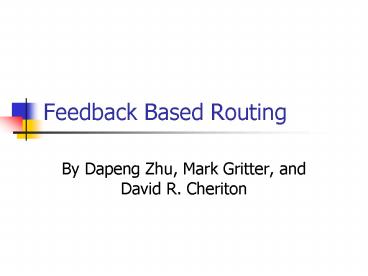Feedback Based Routing PowerPoint PPT Presentation
Title: Feedback Based Routing
1
Feedback Based Routing
- By Dapeng Zhu, Mark Gritter, and David R. Cheriton
2
Outline
- Problems with BGP
- Our solution
- Analysis
- Applications
- Related Work
3
Problems with BGP
- Vulnerability
- Scalability
- Convergence Time
4
Feedback Based Routing
- Overview of system
- Structural Information Propagation
- Algorithm for Access Routers
5
Analysis
- Attack Resistance
- Terrorist Black Holes
- Check!
- Bogus SYN-ACK response
- Nothing to see here, moving along
6
Scalability
- Scales better than BGP for three reasons
- Route computation/propagation removed from
critical path - Availability of routing system does not depend on
in-time computation of shortest paths - Requirements on transit routers are substantially
reduced
7
Scalability (cont)
- This last point is huge!
- Routing system for the Internet backbone should
not be dependent on the exponential growth at the
edge. - Back of the envelope calculation shows
something like a mere 50mb to store an entire
routing table with our scheme
8
Applications
- Defend against The Terrorists(tm) and DoS attacks
- Our scheme would allow for people to throttle DoS
traffic without having to contact upstream
providers - Recognition of a pattern in the DoS traffic is
the only requirement.
9
Applications (cont)
- Virtual Links with Zero Failover Time
- BGP currently has terrible convergence time after
a link failure - We propose highly available virtual links with
zero failover time
10
Overview
- Separate structural and dynamic information
- Core Role
- Forward Packets
- Propagate structural information
- Edge Role
- Routing Decisions
- End to end Probing
11
Structural Information Propagation
- Edges associated with timer
- Renewed with announcement
- Removed from structure at expiration
- Three rule sets for packet forwarding
- Positive
- Negative
- Traffic Engineering
12
Algorithm for Access Routers
- Determine two disjoint routes
- Measure RTT
- TCP
- ICMP
- Periodic Renewing of Backup Routes
13
Related Work
- Differences between previous Byzantine
robustness strategies and ours - Transit routers don't know network topology,
making transit routers almost independent of
network growth - Since most network traffic is TCP, we use TCP SYN
and SYN ACK packets as a measure of network
performance - We are concerned about scalability...they clearly
were not.
14
Related Work (cont)
- Resilient Overlay Network
- Overlay network that tries to get around
routing failures. - We believe this is not sufficient.
- These only work when there are isolated routing
failures - An overlay network could not function during a
The Terrorists(tm) Black Hole attack. Think about
it.
15
Related Work (cont)
- RouteScience, Eye Networks, netVmg
- They do provide possible performance enhancement
(Are these the people spamming me about Ciali?!)
- Since they are edge-only, however, they do not
shield against widespread network failure
16
Conclusion
- Separation of Performance Information and
Structural Information - Routing in the backbone is reduced purely to
Structural Information - Access routers maintain more than one route.
- Helps fight The Terrorists(tm)
17
The End
- Questions?
- Comments?
- Forfeit from the losing Offense team?

